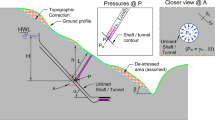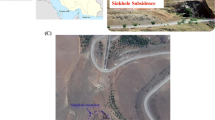Abstract
The occurrence of karst phenomenon is one of the common problems in carbonate rocks in the presence of water. The rock masses constituting the ground surface are mostly of sedimentary types among which carbonate rocks are widely observed. It is therefore necessary to accept such a geological hazard in many projects. Some of the rehabilitation methods for karstic subsidence include grout injection, filling with concrete or shotcrete and making use of geosynthetic products. Few studies have been carried out on the application of the geosynthetic products. Limy rocks form the main lithology of a large part of the 72 km long access road tunnel designed for the Iraqi-Kurdistan. The occurrence of a karstic subsidence with a volume of about 2250 m3 in the portal of Heybat Sultan tunnels revealed the necessity of examining and selecting one of these rehabilitation methods. Concerns about the repetition of such collapses in other tunnels, especially in the 6740 m long Korek twin tunnels that is the longest tunnel of the Middle East located in the vicinity of the project, has doubled the importance of the issue. This paper aims to render an account of the use of shotcrete and geogrid to rehabilitate the subsidence of the portal of Heybat Sultan tunnels. The modeling results with the FLAC numerical finite difference code showed that the displacement amount of the host rock mass after implementing the second method would be 2.9 times less than the first method. Geogrid also reduces the axial forces exerted to the tunnel supporting system up to 43 tons.













Similar content being viewed by others
References
Gutiérrez F, Cooper AH, Johnson KS (2008) Identification, prediction and mitigation of sinkhole hazards in evaporite karst areas. Environ Geol 53:1007–1022. https://doi.org/10.1007/s00254-007-0728-4
Li L, Tu W, Shi S, Chen J, Zhang Y (2016) Mechanism of water inrush in tunnel construction in karst area. Geomat Nat Hazards Risk 7(Suppl 1):35–46. https://doi.org/10.1080/19475705.2016.1181342
Cui QL, Wu HN, Shen SL, Xu YS, Ye G (2015) Chinese karst geology and measures to prevent geohazards during shield tunnelling in karst region with caves. Nat Hazards 77(1):129–152. https://doi.org/10.1007/s11069-014-1585-6
Alija S, Torrijo FJ, Quinta-Ferreira M (2013) Geological engineering problems associated with tunnel construction in karst rock masses: the case of Gavarres tunnel (Spain). Eng Geol 157:103–111. https://doi.org/10.1016/j.enggeo.2013.02.010
Song K, Cho G, Chang S (2012) Identification, remediation, and analysis of karst sinkholes in the longest railroad tunnel in South Korea. Eng Geol 135–136:92–105. https://doi.org/10.1016/j.enggeo.2012.02.018
Li S, Zhou Z, Li L, Xu Z, Zhang Q, Shi S (2013) Risk assessment of water inrush in karst tunnels based on attribute synthetic evaluation system. Tunn Undergr Space Technol 38:50–58. https://doi.org/10.1016/j.tust.2013.05.001
Huang F, Zhaob L, Linga T, Yang X (2017) Rock mass collapse mechanism of concealed karst cave beneath deep tunnel. Int J Rock Mech Min Sci 91:133–138. https://doi.org/10.1016/j.ijrmms.2016.11.017
Elleboudy AM, Saleh NM, Salama AG (2017) Assessment of geogrids in gravel roads under cyclic loading. Alex Eng J 56:319–326. https://doi.org/10.1016/j.aej.2016.09.023
Hussein MG, Meguid MA (2016) A three-dimensional finite element approach for modeling biaxial geogrid with application to geogrid-reinforced soils. Geotext Geomembr 44:295–307. https://doi.org/10.1016/j.geotexmem.2015.12.004
Ziegler M (2017) Application of geogrid reinforced constructions: history, recent and future developments. Procedia Eng 172:42–51. https://doi.org/10.1016/j.proeng.2017.02.015
Kayadelen C, Önal T, Altay G (2018) Experimental study for pull-out load of reinforced sand soil with geogrid. Measurement 117:390–396. https://doi.org/10.1016/j.measurement.2017.12.024
Mekonnen AW, Mandal JN (2017) Behavior of bamboo–geogrid reinforced fly ash wall under applied strip load. Int J Geosynth Ground Eng 3:24. https://doi.org/10.1007/s40891-017-0105-7
Yu Y, Bathurst RJ, Allen TM, Nelson R (2016) Physical and numerical modelling of a geogrid reinforced incremental concrete panel retaining wall. Can Geotech J 53(12):1883–1901. https://doi.org/10.1139/cgj-2016-0207
Biswas A, Ansari MDA, Dash SK, Krishna AM (2015) Behavior of geogrid reinforced foundation systems supported on clay subgrades of different strength. Int J Geosynth Ground Eng 1:20. https://doi.org/10.1007/s40891-015-0023-5
Allen TM, Bathurst RJ (2014) Performance of an 11 m high block-faced geogrid wall designed using the K-stiffness method. Can Geotech J 51(1):16–29. https://doi.org/10.1139/cgj-2013-0261
Shukla SK (2002) Geosynthetics and their applications. Thomas Telford Publishing, London
Shukla SK, Yin JH (2006) Fundamentals of geosynthetic engineering. Taylor and Francis, London
Shukla SK (2012) Handbook of geosynthetic engineering, 2nd edn. ICE Publishing, London
Xiao C, Han J, Zhang Z (2016) Experimental study on performance of geosynthetic-reinforced soil model walls on rigid foundations subjected to static footing loading. Geotext Geomembr 44(1):81–94. https://doi.org/10.1016/j.geotexmem.2015.06.001
Bathurst RJ (1990) Instrumentation of geogrid-reinforced soil walls. Transp Res Rec 1277:102–111
Bathurst RJ, Benjamin DJ, Jarrett PM (1988) Laboratory study of geogrid reinforced soils walls. ASCE special publication no. 18, geosynthetics for soil improvement, pp 178–192
Liu C, Yang K, Ho Y, Chang C (2012) Lessons learned from three failures on a high steep geogrid-reinforced slope. Geotext Geomembr 34:131–143. https://doi.org/10.1016/j.geotexmem.2012.05.003
Ali HF (1993) Field behaviour of a geogrid-reinforced slope. Geotext Geomembr 12(1):53–72. https://doi.org/10.1016/0266-1144(93)90036-N
Daraei A, Herki BMA, Sherwani AFH, Zare S (2018) Slope stability in swelling soils using cement grout: a case study. Int J Geosynth Ground Eng 4:10. https://doi.org/10.1007/s40891-018-0127-9
Reif D, Decker K, Grasemann B, Peresson H (2012) Fracture patterns in the Zagros fold-and-thrust belt, Kurdistan Region of Iraq. Tectonophysics 576–577:46–62. https://doi.org/10.1016/j.tecto.2012.07.024
Frehner M, Reif D, Grasemann B (2012) Mechanical versus kinematical shortening reconstructions of the Zagros High Folded Zone (Kurdistan region of Iraq). Tectonics 31:TC3002. https://doi.org/10.1029/2011TC003010
Beiniawski ZT (1989) Engineering rock mass classifications. Wiley, New York
Daraei R, Herki BMA, Sherwani AFH (2017) Study on the rapid drawdown and its effect on portal subsidence of Heybat Sultan twin tunnels in Kurdistan-Iraq. Civ Eng J 3(7):496–507
Daraei A, Zare S (2018) Effect of water content variations on critical and failure strains of rock. KSCE J Civ Eng. https://doi.org/10.1007/s12205-018-0592-7
Choudhary AK, Krishna AM (2016) Experimental investigation of interface behaviour of different types of granular soil/geosynthetics. Int J Geosynth Ground Eng 2:4. https://doi.org/10.1007/s40891-016-0044-8
Itasca Consulting Group Inc (2002) Fast lagrangian analysis continua. FLAC Ver. 4.0 user manuals
Hoek E, Carranza-Torres C, Diederichs MS, Corkum B (2008) Integration of geotechnical and structural design in tunnelling. In: Proceedings University of Minnesota 56th Annual Geotechnical Engineering Conference, Minneapolis, pp 1–53
Tong J, Karakus M, Wang M, Dong C, Tang X. (2016) Shear strength characteristics of shotcrete–rock interface for a tunnel driven high rock temperature environment. Geomech Geophys Geo-energy Geo-resour 2:331–341. https://doi.org/10.1007/s40948-016-0039-x
Hoek E (2004) Numerical modelling for shallow tunnels in weak rock. Discussion paper # 3. http://www.rocscience.com
Mishra S, Rao KS, Gupta NK, Kumar A (2017) Damage to shallow tunnels under static and dynamic loading. Procedia Eng 173:1322–1329. https://doi.org/10.1016/j.proeng.2016.12.171
Lei M, Lin D, Yang W, Shi C, Peng L, Huang J (2016) Model test to investigate failure mechanism and loading characteristics of shallow-bias tunnels with small clear distance. J Cent South Univ 23:3312–3321. https://doi.org/10.1007/s11771-016-3397-1 .
Sauer G, Gall V, Bauer E, Dietmaier P (1994) Design of tunnel concrete linings using limit capacity curves. In: Siriwardane, Zaman (eds) Computer methods and advances in geomechanics. Balkema, Rotterdam, pp 2621–2626
Hoek E (2003) Integration of geotechnical and structural design in weak rock tunnels. http://www.rocscience.com
Author information
Authors and Affiliations
Corresponding author
Rights and permissions
About this article
Cite this article
Daraei, A., Herki, B.M., Sherwani, A.F.H. et al. Rehabilitation of Portal Subsidence of Heybat Sultan Twin Tunnels: Selection of Shotcrete or Geogrid Alternatives. Int. J. of Geosynth. and Ground Eng. 4, 15 (2018). https://doi.org/10.1007/s40891-018-0132-z
Received:
Accepted:
Published:
DOI: https://doi.org/10.1007/s40891-018-0132-z




